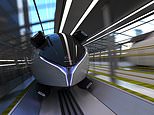
A 500-mile journey from Toronto to Montreal may soon be an easy commute as a startup unveils plans for an ultra-fast flying train.
TransPod, a startup based in Toronto, says its hyperloop-style vacuum train will be able to shuttle passengers at 621mph (1000km/h).
The ‘FluxJet’ trains will levitate through vacuum tubes and be powered by plasma to move as fast as a commercial plane at cruising speed.
And the company says that it has the technology to make this a reality before 2035.
The company is already developing an $18 billion, 186-mile (300 km) line to run between the major Canadian cities of Edmonton and Calgary.
TransPod, a Canadian startup, has announced plans to build a vacuum hyperloop train that can go between Toronto and Montreal in an hour
Ryan Janzen, inventor of the TransPod system, says that the vehicle is ‘built like a plane, but operates like a train.’
Designed like a plane without wings, the FluxJet vehicle is designed to ‘fly’ at high speeds.
Each vehicle is much smaller than a conventional train, closer in size to a single train carriage, and can transport 54 passengers or 10 tonnes of cargo.
Although the capacity is low, TransPod claims it will address this by launching multiple vehicles at the same time.
The company says that using the hyperloop will be 44 per cent cheaper than flying by plane and reduce CO2 emissions by about 636,000 tonnes per year.
The system sends magnetically levitating trains through vacuum tubes to reduce friction as shown in this artist’s rendering
The company plans to build a vacuum hyperloop track from Edmonton to Calgary with a stop in Red Deer, they estimate that this will cost nearly £18bn
What is the fastest train in the world?
The fastest train in the world is the high-speed Maglev between Shanghai and Beijing, China.
It reaches speeds of 370 miles per hour (600km/h).
For comparison most UK trains reach top speeds of 140 miles per hour (225km/h)
The train can complete the 745-mile journey between the cities in just two and a half hours.
To reduce friction as much as possible, the vehicle floats above rails inside a vacuum tube.
A series of strong magnets along the top of the vehicle pull up towards the steel tube while magnets along the bottom push upwards.
FluxJet then uses electromagnets to push the train along to accelerate or decelerate.
This means that there is very little friction or air resistance affecting the train, allowing it to move at very high speeds.
‘You don’t want to touch … anything. Because everything wears out at high speed,’ Mr Janzen says in an interview with CBC.
TransPod joins a number of other companies that have invested in the development of vacuum hyperloop systems.
The first hyperloop model was proposed by Elon Musk in 2013 with a suggestion that it could transport passengers between Los Angeles and San Fransisco.
However, Hyperloop One, which aimed to commercialise Musk’s system, collapsed at the end of last year.
Despite initially receiving backing from Sir Richard Branson, the company announced it would lay off all its workers and sell its assets.
Richard Branson and Virgin removed their brand from the Hyperloop project after the company shifted to focus on cargo rather than passengers.
The company says its trains will be able to hit speeds of 621mph (1000km/h), as fast as a commercial aeroplane
TransPod is currently developing a 186-mile (300km) track to connect the major Canadian cities of Edmonton and Calgary as shown in this rendering
Magnetic levitation trains, or Maglev trains, are already operational in South Korea, China, and Japan.
These trains are among the fastest in the world, with the fastest running between Shanghai and Beijing at 370 miles per hour (600km/h).
Howver, if successful, the FluxJet hyperloop system will be able to reach speeds nearly twice as high.
TransPod says that it is its contactless power system that allows it to move so fast.
The vehicle uses a plasma arc to transfer power from the rails to the vehicle without any contact between the two.
Mr Janzen describes these as ‘virtual wires’ which allow the wireless transfer of power.
An array of sensors and motors within the train itself make constant adjustments to keep the power system in range for charging.
Mr Janzen says that this uses ‘some very fancy control systems and physics’ to keep friction at an absolute minimum.
The technology is currently in the testing phase but TransPod say that it will be operational sometime before 2035
The technology is still in the testing stage, but Mr Janzen says that it could be enabling high-speed commutes between major Canadian cities by 2035.
In 2022, TransPod successfully demonstrated a one-third scale prototype that levitated and moved a nearly one-tonne vehicle.
The company has also begun building a half-scale test track in Droux, France which will be capable of reading 370 miles per hour (600km/h).
Once testing is complete, the next step will be to begin work on a full-scale operational line in Edmonton, Canada.
TransPod has already received $550m (£432m) in investment to build an airport rail link but the final 300km track is expected to cost £17.7 billion.
The company is not receiving any funding from the Canadian Government for this project and intends to fund it privately.
The ultimate goal is to connect the transportation corridor between Quebec City and Chicago, with stops in Montreal, Ottawa, Toronto and Detroit.
Source link
CHECK OUT: Top Travel Destinations
READ MORE: Travel News



